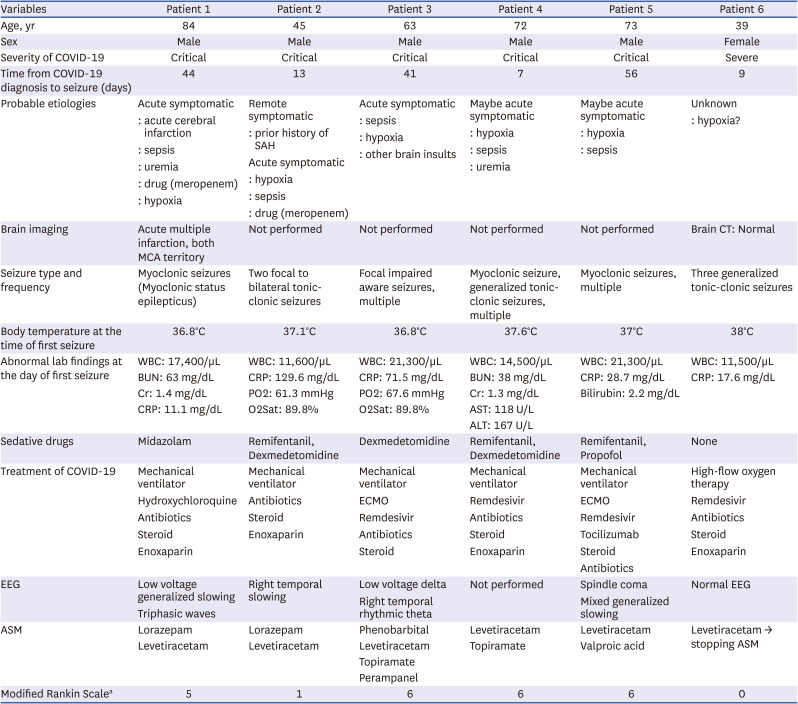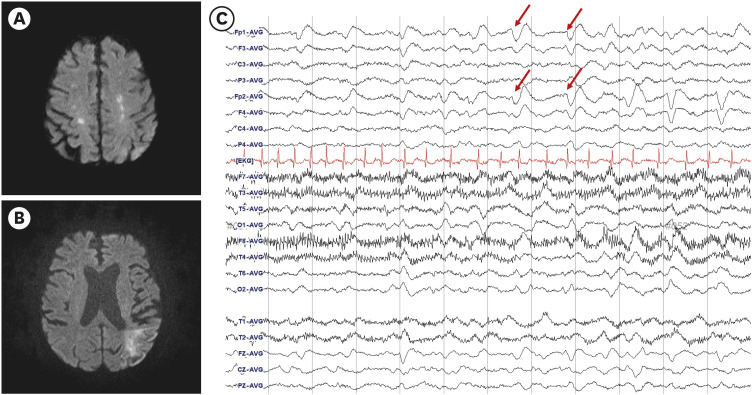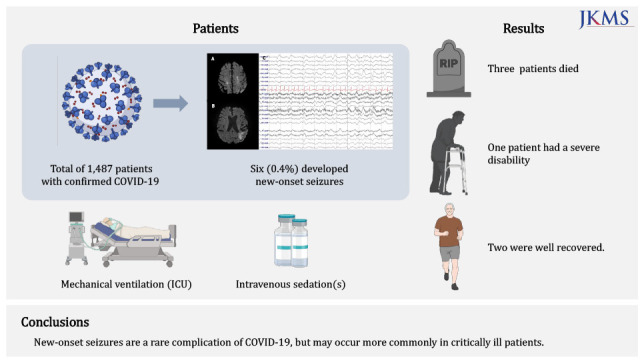2. Misra S, Kolappa K, Prasad M, Radhakrishnan D, Thakur KT, Solomon T, et al. Frequency of neurologic manifestations in COVID-19: a systematic review and meta-analysis. Neurology. 2021; 97(23):e2269–e2281. PMID:
34635561.
3. Mao L, Jin H, Wang M, Hu Y, Chen S, He Q, et al. Neurologic manifestations of hospitalized patients with coronavirus disease 2019 in Wuhan, China. JAMA Neurol. 2020; 77(6):683–690. PMID:
32275288.
4. Pizzi MA. Acute neurologic manifestations of respiratory viruses. Continuum (Minneap Minn). 2021; 27(5):1365–1381. PMID:
34618764.
5. Frontera JA, Sabadia S, Lalchan R, Fang T, Flusty B, Millar-Vernetti P, et al. A prospective study of neurologic disorders in hospitalized patients with COVID-19 in New York City. Neurology. 2021; 96(4):e575–e586. PMID:
33020166.
6. Emami A, Fadakar N, Akbari A, Lotfi M, Farazdaghi M, Javanmardi F, et al. Seizure in patients with COVID-19. Neurol Sci. 2020; 41(11):3057–3061. PMID:
32949289.
7. Eskandar EN, Altschul DJ, de la Garza Ramos R, Cezayirli P, Unda SR, Benton J, et al. Neurologic syndromes predict higher in-hospital mortality in COVID-19. Neurology. 2021; 96(11):e1527–e1538. PMID:
33443111.
8. Vohora D, Jain S, Tripathi M, Potschka H. COVID-19 and seizures: is there a link? Epilepsia. 2020; 61(9):1840–1853. PMID:
32944929.
9. Bhagat R, Kwiecinska B, Smith N, Peters M, Shafer C, Palade A, et al. New-onset seizure with possible limbic encephalitis in a patient with COVID-19 infection: a case report and review. J Investig Med High Impact Case Rep. 2021; 9:2324709620986302.
10. Keyhanian K, Umeton RP, Mohit B, Davoudi V, Hajighasemi F, Ghasemi M. SARS-CoV-2 and nervous system: From pathogenesis to clinical manifestation. J Neuroimmunol. 2020; 350:577436. PMID:
33212316.
11. Le Guennec L, Devianne J, Jalin L, Cao A, Galanaud D, Navarro V, et al. Orbitofrontal involvement in a neuroCOVID-19 patient. Epilepsia. 2020; 61(8):e90–e94. PMID:
32589794.
12. Narula N, Joseph R, Katyal N, Daouk A, Acharya S, Avula A, et al. Seizure and COVID-19: association and review of potential mechanism. Neurol Psychiatry Brain Res. 2020; 38:49–53. PMID:
33071468.
13. Matschke J, Lütgehetmann M, Hagel C, Sperhake JP, Schröder AS, Edler C, et al. Neuropathology of patients with COVID-19 in Germany: a post-mortem case series. Lancet Neurol. 2020; 19(11):919–929. PMID:
33031735.
14. Lewis A, Frontera J, Placantonakis DG, Lighter J, Galetta S, Balcer L, et al. Cerebrospinal fluid in COVID-19: a systematic review of the literature. J Neurol Sci. 2021; 421:117316. PMID:
33561753.
15. Li YC, Bai WZ, Hashikawa T. The neuroinvasive potential of SARS-CoV2 may play a role in the respiratory failure of COVID-19 patients. J Med Virol. 2020; 92(6):552–555. PMID:
32104915.
16. Yachou Y, El Idrissi A, Belapasov V, Ait Benali S. Neuroinvasion, neurotropic, and neuroinflammatory events of SARS-CoV-2: understanding the neurological manifestations in COVID-19 patients. Neurol Sci. 2020; 41(10):2657–2669. PMID:
32725449.
17. Tancheva L, Petralia MC, Miteva S, Dragomanova S, Solak A, Kalfin R, et al. Emerging neurological and psychobiological aspects of COVID-19 infection. Brain Sci. 2020; 10(11):E852. PMID:
33198412.
18. Carroll E, Melmed KR, Frontera J, Placantonakis DG, Galetta S, Balcer L, et al. Cerebrospinal fluid findings in patients with seizure in the setting of COVID-19: A review of the literature. Seizure. 2021; 89:99–106. PMID:
34044299.
19. Beghi E, Carpio A, Forsgren L, Hesdorffer DC, Malmgren K, Sander JW, et al. Recommendation for a definition of acute symptomatic seizure. Epilepsia. 2010; 51(4):671–675. PMID:
19732133.
20. Karceski S.. Acute symptomatic seizures and systemic illness. Continuum (Minneap Minn). 2014; 20(3):614–623. PMID:
24893237.
21. Chua TH, Xu Z, King NK. Neurological manifestations in COVID-19: a systematic review and meta-analysis. Brain Inj. 2020; 34(12):1549–1568. PMID:
33074036.
22. Anand P, Al-Faraj A, Sader E, Dashkoff J, Abdennadher M, Murugesan R, et al. Seizure as the presenting symptom of COVID-19: a retrospective case series. Epilepsy Behav. 2020; 112:107335. PMID:
32739397.
23. Mithani F, Poursheykhi M, Ma B, Smith RG, Hsu SH, Gotur D. New-onset seizures in three COVID-19 patients: a case series. J Clin Neurophysiol. 2021; 38(2):e5–10. PMID:
33315693.
24. Pellinen J, Carroll E, Friedman D, Boffa M, Dugan P, Friedman DE, et al. Continuous EEG findings in patients with COVID-19 infection admitted to a New York academic hospital system. Epilepsia. 2020; 61(10):2097–2105. PMID:
32875578.
25. Oddo M, Carrera E, Claassen J, Mayer SA, Hirsch LJ. Continuous electroencephalography in the medical intensive care unit. Crit Care Med. 2009; 37(6):2051–2056. PMID:
19384197.
26. Gilmore EJ, Gaspard N, Choi HA, Cohen E, Burkart KM, Chong DH, et al. Acute brain failure in severe sepsis: a prospective study in the medical intensive care unit utilizing continuous EEG monitoring. Intensive Care Med. 2015; 41(4):686–694. PMID:
25763756.
27. Bleck TP, Smith MC, Pierre-Louis SJ, Jares JJ, Murray J, Hansen CA. Neurologic complications of critical medical illnesses. Crit Care Med. 1993; 21(1):98–103. PMID:
8420739.
28. Ferlisi M, Shorvon S. Seizure precipitants (triggering factors) in patients with epilepsy. Epilepsy Behav. 2014; 33:101–105. PMID:
24632482.
29. Hepburn M, Mullaguri N, George P, Hantus S, Punia V, Bhimraj A, et al. Acute symptomatic seizures in critically ill patients with COVID-19: is there an association? Neurocrit Care. 2021; 34(1):139–143. PMID:
32462412.






 PDF
PDF Citation
Citation Print
Print




 XML Download
XML Download